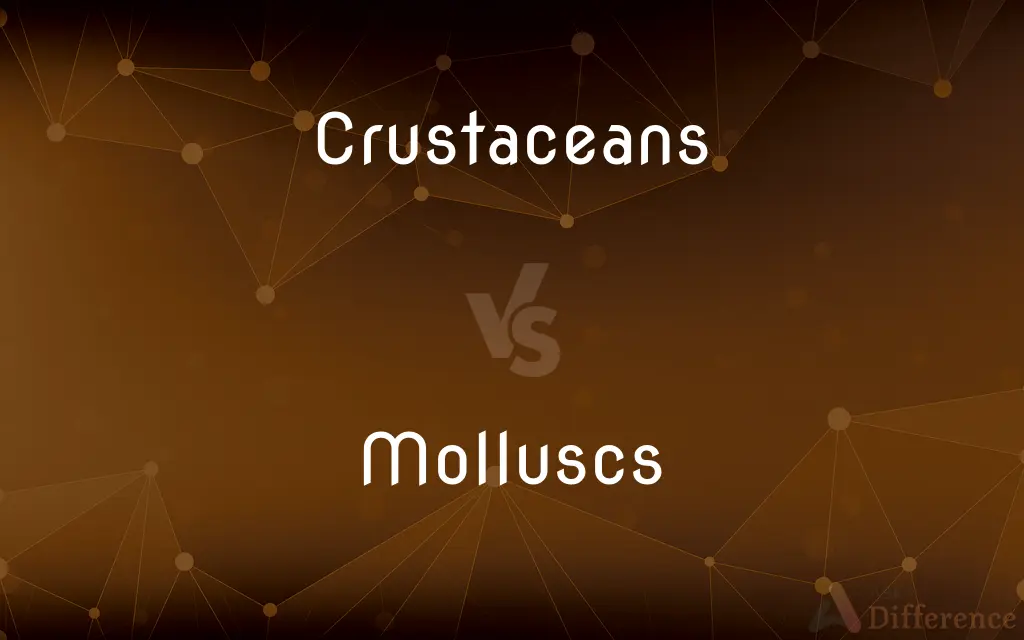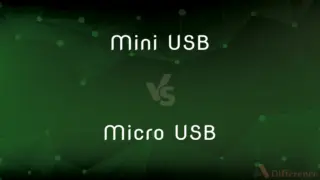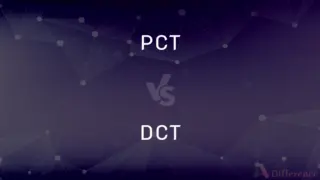Crustaceans vs. Molluscs — What's the Difference?
Edited by Tayyaba Rehman — By Fiza Rafique — Published on December 2, 2023
Crustaceans are primarily aquatic arthropods with hard exoskeletons, like crabs and shrimp, while Molluscs are soft-bodied invertebrates, often with shells, such as snails and clams.

Difference Between Crustaceans and Molluscs
Table of Contents
ADVERTISEMENT
Key Differences
Crustaceans belong to the class Crustacea within the phylum Arthropoda. These organisms are characterized by their jointed appendages and hard exoskeleton, which they molt to grow. Molluscs, on the other hand, belong to the phylum Mollusca and are known for their soft bodies, which may or may not be enclosed in a calcium carbonate shell.
When observing a crustacean, you might notice its segmented body, which is a common trait among arthropods. Crustaceans typically possess two main body parts: the cephalothorax (head and thorax combined) and the abdomen. Molluscs have a more varied body plan, often characterized by a visceral mass, a foot, and a mantle which might secrete a shell.
The habitat and locomotion of crustaceans and molluscs also differ. While most crustaceans are aquatic, living in both freshwater and marine environments, molluscs can be found in terrestrial, freshwater, and marine habitats. The way they move varies too, with crustaceans often walking or swimming, and molluscs using muscular feet or jet propulsion.
Crustaceans have a wide variety of species, from the tiny copepods to the much larger lobsters and crabs. Their exoskeleton provides them with protection against potential threats. Molluscs, on the other hand, range from small organisms like slugs and snails to larger creatures like octopuses and squids. Their shells, when present, offer protection and structural support.
In terms of economic importance, crustaceans like shrimp, crabs, and lobsters are major seafood commodities. Molluscs, including clams, oysters, and squids, also have significant commercial value, with many being consumed as delicacies worldwide.
ADVERTISEMENT
Comparison Chart
Phylum
Arthropoda
Mollusca
Body Type
Segmented with hard exoskeleton
Soft-bodied, often with a shell
Primary Habitat
Mostly aquatic
Terrestrial, freshwater, and marine
Common Examples
Crabs, shrimp, lobsters
Snails, clams, squids, octopuses
Economic Importance
Major seafood commodities
Consumed as delicacies and seafood
Compare with Definitions
Crustaceans
Creatures characterized by jointed limbs and segmented bodies.
The anatomy of crustaceans is complex, with many segments and jointed appendages.
Molluscs
Members of the phylum Mollusca, exhibiting diverse body plans.
Molluscs are incredibly varied, from clams buried in sand to octopuses swimming freely.
Crustaceans
Aquatic arthropods known for their hard exoskeletons.
Crabs and lobsters are popular crustaceans eaten worldwide.
Molluscs
Many species have significant commercial importance as seafood or delicacies.
Oysters and clams are molluscs that are prized for their taste and texture.
Crustaceans
Members of the class Crustacea within the phylum Arthropoda.
Crustaceans are fascinating creatures with diverse species ranging from tiny to quite large.
Molluscs
Invertebrates known for their soft bodies, which may be encased in shells.
Snails, with their coiled shells, are common molluscs found in gardens.
Crustaceans
Species that are mostly aquatic, inhabiting both freshwater and marine environments.
You can find crustaceans in diverse habitats, from freshwater lakes to the deep sea.
Molluscs
Organisms found in a variety of habitats, including terrestrial, marine, and freshwater environments.
While many people think of molluscs as sea creatures, some like snails are land dwellers.
Crustaceans
Organisms that molt their exoskeleton to grow.
It's interesting to find the shed exoskeleton of crustaceans along the beach.
Molluscs
Creatures that might possess a foot, visceral mass, and a mantle.
The protective shell of many molluscs is secreted by their mantle.
Crustaceans
Plural of crustacean
Molluscs
Any of numerous chiefly marine invertebrates of the phylum Mollusca, typically having a soft unsegmented body, a mantle, and a protective calcareous shell, and including the snails, clams, and squids.
Molluscs
Variant of mollusk.
Molluscs
Plural of mollusc
Common Curiosities
Are snails considered molluscs?
Yes, snails are a type of mollusc.
Do all molluscs have shells?
No, not all molluscs have shells; for instance, octopuses and slugs don't.
How do crustaceans grow with a hard exoskeleton?
Crustaceans molt, shedding their old exoskeleton and forming a new one.
Do any crustaceans live on land?
While most are aquatic, some, like certain crabs, can live on land.
What are some examples of crustaceans?
Examples include crabs, lobsters, and shrimp.
What do crustaceans have that molluscs don't?
Crustaceans have a hard exoskeleton and jointed limbs.
What's the function of a mollusc's mantle?
The mantle secretes the shell in molluscs that have one.
Is an octopus a mollusc?
Yes, octopuses belong to the mollusc class Cephalopoda.
Which group is more diverse, crustaceans or molluscs?
Both are diverse, but molluscs, with over 85,000 species, are one of the most diverse animal phyla.
Are all crustaceans edible?
Not all, but many, like crabs and shrimp, are popular foods.
Which is older evolutionarily, crustaceans or molluscs?
Both have ancient origins, but fossil evidence suggests molluscs appeared slightly earlier in the evolutionary timeline.
How do molluscs move?
It varies: snails use a muscular foot, while squids use jet propulsion.
How do crustaceans breathe?
Most crustaceans breathe through gills.
Do crustaceans have eyes?
Most crustaceans have compound eyes on stalks.
Are molluscs vertebrates or invertebrates?
Molluscs are invertebrates.
Share Your Discovery

Previous Comparison
Mini USB vs. Micro USB
Next Comparison
PCT vs. DCTAuthor Spotlight
Written by
Fiza RafiqueFiza Rafique is a skilled content writer at AskDifference.com, where she meticulously refines and enhances written pieces. Drawing from her vast editorial expertise, Fiza ensures clarity, accuracy, and precision in every article. Passionate about language, she continually seeks to elevate the quality of content for readers worldwide.
Edited by
Tayyaba RehmanTayyaba Rehman is a distinguished writer, currently serving as a primary contributor to askdifference.com. As a researcher in semantics and etymology, Tayyaba's passion for the complexity of languages and their distinctions has found a perfect home on the platform. Tayyaba delves into the intricacies of language, distinguishing between commonly confused words and phrases, thereby providing clarity for readers worldwide.
















































